
Conan the Indestructible

The greatest hero of the magic-rife Hyborian Age was a northern barbarian, Conan the Cimmerian, about whose deeds a cycle of legend revolves. While these legends are largely based on the attested facts of Conan's life, some tales are inconsistent with others. So we must reconcile the contradictions in the saga as best we can. In Conan's veins flowed the blood of the people of Atlantis, the brilliant city-state swallowed by the sea 8,000 years before his time. He was born into a clan that claimed a homeland in the northwest corner of Cimmeria, along the shadowy borders of Vanaheim and the Pictish wilderness. His grandfather had fled his own people because of a blood feud and sought refuge with the people of the North. Conan himself first saw daylight on battlefield during a raid by the Vanir.
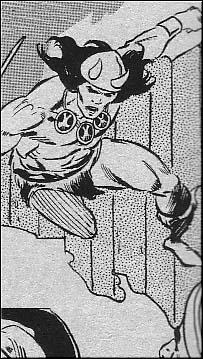
Before he had weathered fifteen snows the young Cimmerian's fighting skills were acclaimed around the council fires. In that year the Cimmerians, usually at one another's throats, joined forces to repel the warlike Gundermen who, intent on colonizing southern Cimmeria, had pushed across the Aquilonian border and established the frontier post of Venarium. Conan joined the howling, blood-mad horde that swept out of the northern hills, stormed over the stockade walls, and drove the Aquilonians back across their frontier.
At the sack of Venarium, Conan, still short of his full growth, stood six feet tall and weighed 180 pounds. He had the vigilance and stealth of the born woodsman, the iron-hardness of the mountain man, and the Herculean physique of his blacksmith father. After the plunder of the Aquilonian outpost, Conan returned for a time to his tribe.
Restless under the conflicting passions of his adolescence, Conan spent several months with a band of Aesir as they raided the Vanir and the Hyperboreans. He soon learned that some Hyperborean citadels were ruled by a caste of widely feared magicians, called Witchmen. Undaunted, he took part in a foray against Haloga Castle, when he found that Hyperborean slavers had captured Rann, the daughter of Njal, chief of the Aesir band.
Conan gained entrance to the castle and spirited out Rann Njalsdatter, but on the flight out of Hyperborea, Njal's band was overtaken by an army of living dead. Conan and the other Aesir survivors were led away to slavery ("Legions of the Dead").
Conan did not long remain a captive. Working at night, he ground away at one link of his chain until it was weak enough to break. Then one stormy night, whirling a four-foot length of heavy chain, he fought his way out of the slave pen and vanished into the downpour.
Another account of Conan's early years tells a different tale. This narrative, on a badly broken clay prism from Nippur, states that Conan was enslaved as a boy of ten or twelve by Vanir raiders and set to work turning a grist mill. When he reached his full growth, he was bought by a Hyrkanian pitmaster who traveled with a band of professional fighters staging contests for the musement of the Vanir and Aesir. At this time Conan received his training with weapons. Later he escaped and made his way south to Zamora ("Conan the Barbarian").
Of the two versions, the records of Conan's enslavement by the Hyrkanians at sixteen, found in a papyrus in the British Museum, appear much more legible and self-consistent. But this question may never be settled.
Although free, the youth found himself half a hostile kingdom away from home. Instinctively he fled into the mountains at the southern extremity of Hyperborea. Pursued by a pack of wolves, he took refuge in a cave. Here he discovered the seated mummy of a gigantic chieftain of ancient times, with a heavy bronze sword across its knees. When Conan seized the sword, the corpse arose and attacked him ("The Thing in the Crypt").
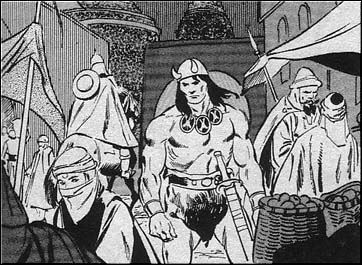
Continuing southward into Zamora, Conan came to Arenjun, the notorious "City of Thieves." Green to civilization and, save for some rudimentary barbaric ideas of honor and chivalry, wholly lawless by nature, he carved a niche for himself as a professional thief.
Being young and more daring than adroit, Conan's progress in his new profession was slow until he joined forces with Taurus of Nemedia in a quest for the fabulous jewel called the "Heart of the Elephant." The gem lay in the almost impregnable tower of the infamous mage Yara, captor of the extraterrestrial being Yag-Kosha ("The Tower of the Elephant").
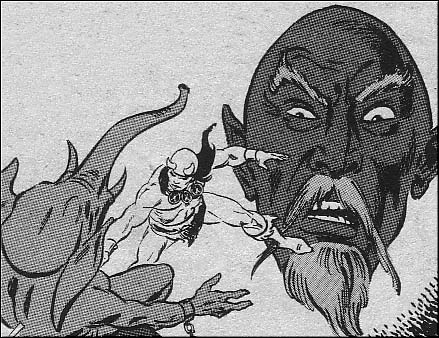
Seeking greater opportunities to ply his trade, Conan wandered westward to the capital of Zamora, Shadizar the Wicked. For a time his thievery prospered, although the whores of Shadizar soon relieved him of his gains. During one larceny, he was captured by the men of Queen Taramis of Shadizar, who sent him on a mission to recover a magical horn wherewith to resurrect an ancient, evil god. Taramis's plot led to her own destruction ("Conan the Destroyer").
The barbarian's next exploit involved a fellow thief, a girl named Tamira. The Lady Jondra, an arrogant aristocrat of Shadizar, owned a pair of priceless rubies. Baskaran Imalla, a religious fanatic raising a cult among the Kezankian hillmen, coveted the jewels to gain control over a fire-breathing dragon he had raised from an egg. Conan and Tamira both yearned for the rubies; Tamira took a post as lady's maid to Jondra for a chance steal them.
An ardent huntress, Jondra set forth with her maid and her men-at-arms to slay Baskaran's dragon. Baskaran captured the two women and was about to offer them to his pet as a snack when Conan intervened ("Conan the Magnificent").
Soon Conan was embroiled in another adventure. A stranger hired the youth to steal a casket of gems sent by the King of Zamora to the King of Turan. The stranger, a priest of the serpent god Set, wanted the jewels for magic against his enemy, the renegade priest Amanar.
Amanar's emissaries, who were hominoid reptiles, had stolen the gems. Although wary of magic, Conan set out to recover the loot. He became involved with a bandette, Karela, called the Red Hawk, who proved the ultimate bitch; when Conan saved her from rape, she tried to kill him. Amanar's party had also carried off to the renegade's stronghold a dancing girl whom Conan had promised to help ("Conan the Invincible").
Soon rumors of treasure sent Conan to the nearby ruins of ancient Larsha, just ahead of the soldiers dispatched to arrest him. After all but their leader, Captain Nestor, had perished in an accident arranged by Conan, Nestor and Conan joined forces to plunder the treasure; but ill luck deprived them of their gains ("The Hall of the Dead").
Conan's recent adventures had left him with an aversion to warlocks and Eastern sorceries. He fled northwestward through Corinthia into Nemedia, the second most powerful Hyborian kingdom. In Nemedia he resumed his profession successfully enough to bring his larcenies to the notice of Aztrias Petanius, ne'er-do-well nephew of the governor. Oppressed by gambling debts, this young gentleman hired the outlander to purloin a Zamorian goblet, carved from a single diamond, that stood in the temple-museum of a wealthy collector.
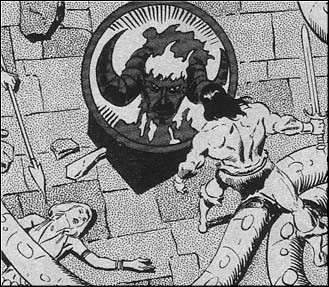
Conan's appearance in the temple-museum coincided with its master's sudden demise and brought the young thief to the unwelcome attention of Demetrio, of the city's Inquisitorial Council. This caper also gave Conan his second experience with the dark magic of the serpent-brood of Set conjured up by the Stygian sorcerer Thoth-Amon ("The God in the Bowl").
Having made Nemedia too hot to hold him Conan drifted south into Corinthia, where he continued to occupy himself with the acquisition of other persons' property. By diligent application, the Cimmerian earned the repute of one of the boldest thieves in Corinthia. Poor judgment of women, however, cast him into chains until a turn in local politics brought freedom and a new career. An ambitious nobleman, Murilo, turned him loose to slit the throat of the Red Priest, Nalaonidus, the scheming power behind the local throne. This venture gathered a prize collection of rogues in Nabodinus's mansion and ended in a mire of blood and treachery ("Rogues in the House").
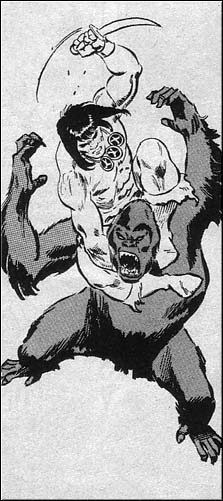
Conan wandered back to Arenjun and began to earn a semi-honest living by stealing back for their owners valuable objects that others had filched from them. He undertook to recover a magical gem, the Eye of Erlik, from the wizard Hissar Zul and return it to its owner, the Khan of Zamboula.
There is some question about the chronology of Conan's life at this point. A recently-translated tablet from Asshurbanipal's library states that Conan was about seventeen at the time. This would place the episode right after that of "The Tower the Elephant," which indeed is mentioned in the cuneiform. But from internal evidence, this event seems to have taken place several years later. For one thing, Conan appears too clever, mature, and sophisticated; for another, the fragmentary medieval Arabic manuscript Kitab al-Qunn implies that Conan was well into his twenties by then.
The first translator of the Asshurbanipal tablet, Prof. Dr. Andreas von Fuss of the Munchner Staatsmuseum, read Conan's age as "17." In Babylonian cuneiform, "17" is expressed by two circles followed by three vertical wedges, with a horizontal wedge above the three for "minus" -- hence "twenty minus three." But Academician Leonid Skram of the Moscow Archaeological Institute asserts that the depression over the vertical wedges is merely a dent made by the pick of a careless excavator, and the numeral properly reads "23".
Anyhow, Conan learned of the Eye of Erlik when he heard a discussion between an adventuress, Isparana, and her confederate. He invaded the wizard's mansion, but the wizard caught Conan and deprived him of his soul. Conan's soul was imprisoned in a mirror, there to remain until a crowned ruler broke the glass. Hissar Zul thus compelled Conan to follow Isparana and recover the talisman; but when the Cimmerian returned the Eye to Hissar Zul, the ungrateful mage tried to slay him ("Conan and the Sorcerer").
Conan, his soul still englassed, accepted legitimate employment as bodyguard to a Khaurani noblewoman, Khashtris. This lady set out for Khauran with Conan, another guard, Shubal, and several retainers. When the other servants plotted to rob and murder their employer, Conan and Shubal saved her and escorted her to Khauran. There Conan found the widowed Queen Ialamis being courted by a young nobleman who was not at all what he seemed ("Conan the Mercenary").
With his soul restored, Conan learned from an Iranistani, Khassek, that the Khan of Zamboula still wanted the Eye of Erlik. In Zamboula, the Turanian governor, Akter Khan, had hired the wizard Zafra, who ensorcelled swords so that they would slay on command. En route, Conan encountered Isparana, with whom he developed a lust-hate relationship. Unaware of the magical swords, Conan continued to Zamboula and delivered the amulet. But the nefarious Zafra convinced the Khan that Conan was dangerous and should be killed on general principles ("Conan: The Sword of Skelos").
Conan had enjoyed his taste of Hyborian-Age intrigue. It became clear that there was no basic differance between the opportunities in the palace and those in the Rats' Den, whereas the pickings were far better in high places. Besides, he wearied of the furtive, squalid life of a thief.
He was not, however, yet committed to a strictly law-abiding life. When unemployed, he took time out for a venture in smuggling. An attempt to poison him sent him to Vendhya, a land of wealth and squalor, philosophy and fanatacism, idealism and treachery ("Conan the Victorious").
Soon after, Conan turned up in the Turanian seaport of Aghrapur. A new cult had established headquarters there under the warlock Jhandar, who needed victims to be drained of blood and reanimated as servants. Conan refused the offer of a former fellow thief, Emilio, to take part in a raid on Jhandar's stronghold to steal a fabulous ruby necklace. A Turanian sergeant, Akeba, did however persuade Conan to go with him to rescue Akeba's daughter, who had vanished into the cult ("Conan the Unconquered").
After Jhandar's fall, Akeba urged Conan to take service in the Turanian army. The Cimmerian did not at first find military life congenial, being too self-willed and hot-tempered to easily submit to discipline. Moreover, as he was at this time an indifferent horseman and archer, Conan was relegated to a low-paid irregular unit.
Still, a chance soon arose to show his mettle. King Yildiz launched an expedition against a rebellious satrap. By sorcery, the satrap wiped out the force sent against him. Young Conan alone survived to enter the magic-maddened satrap' city of Yaralet ("The Hand of Nergal").
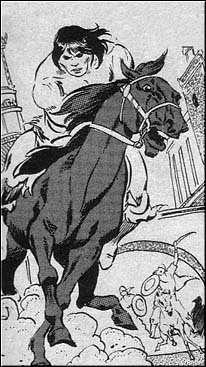
Returning in triumph to the glittering capital of Aghrapur, Conan gained a place in King Yildiz's guard of honor. At first he endured the gibes of fellow troopers at his clumsy horsemanship and inaccurate archery. But the gibes died away as the other guardsmen discovered Conan's sledge-hammer fists and as his skills improved.
Conan was chosen, along with a Kushite mercenary named Juma, to escort King Yildiz's daughter Zosara to her wedding with Khan Kujula, chief of the Kuigar nomads. In the foothills of the Talakma Mountains, the party was attacked by a strange force of squat, brown, lacquer-armored horsemen. Only Conan, Juma, and the princess survived. They were taken to the subtropical valley of Meru and to the capital, Shamballah, where Conan and Juma were chained to an oar of the Meruvian state galley, about to set forth on a cruise.
On the galley's return to Shamballah, Conan and Juma escaped and made their way into the city. They reached the temple of Yama as the deformed little god-king of Meru was celebrating his marriage to Zosara ("The City of Skulls").
Back at Aghrapur, Conan was promoted to captain. His growing repute as a good man in a tight spot, however, led King Yildiz's generals to pick the barbarian for especially hazardous missions. Once they sent Conan to escort an emissary to the predatory tribesmen of the Khozgari Hills, hoping to dissuade them by bribes and threats from plundering the Turanians of the lowlands. The Khozgarians, respecting only immediate, overwhelming force, attacked the detachment, killing the emissary and all but two of the soldiers, Conan and Jamal.
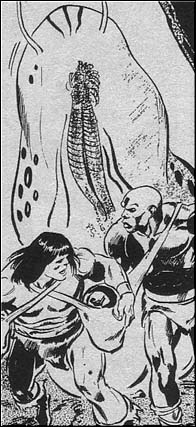
To assure their safe passage back to civilization, Conan and Jamal captured Shanya, the daughter of the Khozgari chief. Their route led them to a misty highland. Jamal and the horses were slain, and Conan had to battle a horde of hairless apes and invade the stronghold of an ancient, dying race ("The People of the Summit").
Another time, Conan was dispatched thousands of miles eastward, to fabled Khitai, to convey to King Shu of Kusan a letter from King Yildiz proposing a treaty of friendship and trade. The wise old Khitan king sent his visitors back with a letter of acceptance. As a guide, however, the king appointed a foppish little nobleman, Duke Feng, who had entirely different objectives ("The Curse of the Monolith", first published as "Conan and the Cenotaph").
Conan continued in his service in Turan for about two years, traveling widely and learning the elements of organized, civilized warfare. As usual, trouble was his bedfellow. After one of his more unruly adventures, involving the mistress of his superior officer, Conan deserted and headed for Zamora. In Shadizar he heard that the Temple of Zath, the spider god, in the Zamorian city of Yezud, was recruiting soldiers. Hastening to Yezud, Conan found that a Brythunian free company had taken all the available mercenary posts. He became the town's blacksmith because as a boy he had been apprenticed in this trade.
Conan learned from an emissary of King Yildiz, Lord Parvez, that High Priest Feridun was holding Yildiz's favorite wife, Jamilah, in captivity. Parvez hired Conan to abduct Jamilah. Meanwhile Conan had set his heart on the eight huge gems that formed the eyes of an enormous statue of the spider god. As he was loosening the jewels, the approach of priests forced him to flee to a crypt below the naos. The temple dancing girl Rudabeh, with whom Conan was truly in love for the first time in his life, descended into the crypt to warn him of the doom awaiting him there ("Conan and the Spider God").
Conan next rode off to Shadizar to track down a rumor of treasure. He obtained a map showing the location of a ruby-studded golden idol in the Kezankian Mountains; but thieves stole his map. Conan, pursuing them, had a brush with Kezankian hillmen and had to join forces with the very rogues he was tracking. He found the treasure, only to lose it under strange circumstances ("The Bloodstained God").
Fed up with magic, Conan headed for the Cimmerian hills. After a time in the simple, routine life of his native village, however, he grew restless enough to join his old friends, the Aesir, in a raid into Vanaheim. In a bitter struggle on the snow-covered plain, both forces were wiped out -- all but Conan, who wandered off to a strange encounter with the legendary Atali, daughter of the frost giant Ymir ("The Frost Giant's Daughter").
Haunted by Atali's icy beauty, Conan headed back toward the South, where, despite his often voiced scorn of civilization, the golden spires of teeming cities beckoned. In the Eiglophian Mountains, Conan rescued a young woman from cannibals, but through overconfidence lost her to the dreaded monster that haunted glaciers ("The Lair the Ice Worm").
Conan then returned to the Hyborian lands, which include Aquilonia, Argos, Brythunia, Corinthia, Koth, Nemedia, Ophir, and Zingara. These countries were named for the Hyborian peoples who as barbarians, had 3,000 years earlier conquered the empire of Acheron and built civilized realms on its ruins.
In Belverus, the capital of Nemedia, the ambitious Lord Albanus dabbled in sorcery to usurp the throne of King Garian. To Belverus came Conan, seeking a patron with money to enable him to hire his own free company. Albanus gave a magical sword to a confederate, Lord Melius, who went mad and attacked people in the street until killed. As he picked up the ensorcelled sword, Conan was accosted by Hordo, a one-eyed thief and smuggler whom he had known as Karela's lieutenant.
Conan sold the magical sword, hired his own free company, and taught his men mounted archery. Then he persuaded King Garian to hire him. But Albanus had made a man of clay and by his sorcery given it the exact appearance of the king. Then he imprisoned the king, substituted his golem, and framed Conan for murder ("Conan the Defender").
Conan next brought his free company to Ian, the capital of Ophir. There the Lady Synelle, a platinum-blond sorceress, wished to bring to life the demon-god Al'Kirr. Conan bought a statuette of this demon-god and soon found that various parties were trying to steal it from him. He and his company took service under Synelle, not knowing her plans.
Then the bandette Karela reappeared and, as usual, tried to murder Conan. Synelle hired her to steal the statuette, which the witch needed for her sorcery. She also planned to sacrifice Karela ("Conan the Triumphant").
Conan went on to Argos; but since that kingdom was at peace, there were no jobs for mercenaries. A misunderstanding with the law compelled Conan to leap to the deck of a ship as it left the pier. This was the merchant galley Argus, bound for the coasts of Kush.
A major epoch in Conan's life was about to begin. The Argus was taken by Belit, the Shemite captain of the pirate ship Tigress, whose ruthless black corsairs had made her mistress of the Kushite littoral. Conan won both Belit and a partnership in her bloody trade ("Queen of the Black Coast," Chapter 1).
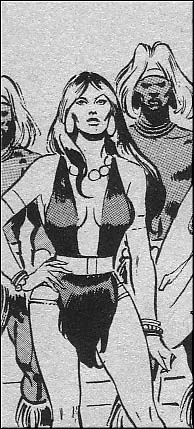
Years before, Belit, daughter of a Shemite trader, had been abducted with her brother Jehanan by Stygian slavers. Now she asked her lover Conan to try to rescue the youth. The barbarian slipped into Khemi, the Stygian seaport, was captured, but escaped to the eastern end of Stygia, the province of Taia, where a revolt against Stygian oppression was brewing ("Conan the Rebel").
Conan and Belit resumed their piratical careers, preying mainly on Stygian vessels. Then an ill fate took them up the black Zarkheba River to the lost city of an ancient winged race ("Queen of the Black Coast," Chapters 2-5).
As Belit's burning funeral ship wafted out to sea, a downhearted Conan turned his back on the sea, which he would not follow again for years. He plunged inland and joined the warlike Bamulas, a black tribe whose power swiftly grew under his leadership.
The chief of a neighboring tribe, the Bakalahs, planned a treacherous attack on another neighbor and invited Conan and his Bamulas to take part in the sack and massacre. Conan accepted but, learning that an Ophirean girl, Livia, was held captive in Bakalah, he out-betrayed the Bakalahs. Livia ran off during the slaughter and wandered into a mysterious valley, where only Conan's timely arrival saved her from being sacrificed to an extraterrestrial being ("The Vale of Lost Women").
Before Conan could build his own black empire he was thwarted by a succession of natural catastrophes as well as by the intrigues of hostile Bamulas. Forced to flee, he headed north. After a narrow escape from pursuing lions on the veldt, Conan took shelter in a mysterious ruined castle of prehuman origin. He had a brush with Stygian slavers and a malign supernatural entity ("The Castle of Terror").
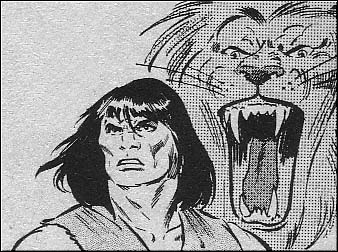
Continuing on, Conan reached the semicivilized kingdom of Kush. This was the land to which the name "Kush" properly applied; although Conan like other Northerners, tended to use the term loosely to mean any of the black countries south of Stygia. In Meroe, the capital, Conan rescued from a hostile mob the young Queen of Kush, the arrogant, impulsive, fierce, cruel, and voluptuous Tananda.
Conan became embroiled in a labyrinthine intrigue between Tananda and an ambitious nobleman who commanded a piglike demon. The problem was aggravated by the presence of Diana, a Nemedian slave girl, to whom Conan, despite the Jealous fury of Tananda, took a fancy. Events culminated in a night of insurrection and slaughter ("The Snout in the Dark").
Dissatisfied with his achievements in the black countries, Conan wandered to the meadowlands of Shem and became a soldier of Akkharia, a Shemite city-state. He joined a band of volunteers to liberate a neighboring city-state, but through the teachery of Othbaal, cousin of the mad King Akhirom of Pelishtia, the volunteers were destroyed -- all but Conan, who survived to track the plotter to Asgalun, the Pelishti capital. There Conan became involved in a polygonal power war among the mad Akhirom, the treacherous Othbaal, a Stygian witch, and a company of black mercenaries. In the final hurly-burly of sorcery, steel, and blood, Conan grabbed Othbaal's red-haired mistress, Rufia, and galloped north ("Hawks Over Shem").
Conan's movements at this time are uncertain. One tale, sometimes assigned to this period, tells of Conan's service as a mercenary in Zingara. A Ptolemaic papyrus in the British Museum alleges that in Kordava, the capital, a captain in the regular army forced a quarrel on Conan. When Conan killed his assailant, he was condemned to hang. A fellow condemnee, Santiddio, belonged to an underground conspiracy, the White Rose, that hoped to topple King Rimanendo. As other conspirators created a disturbance in the crowd that gathered for the hanging, Conan and Santiddio escaped.
Mordermi, head of an outlaw band allied with the White Rose, enlisted Conan in his movement. The conspiracy was carried on in the Pit, a warren of tunnels beneath the city. When the King sent an army to clean out the Pit, the insurrectionists were saved by Callidos, a Stygian sorcerer. King Rimanendo was slain and Mordermi became king. When he proved as tyrannical as his predecessor, Conan raised another revolt; then, refusing the crown for himself, he departed ("Conan: The Road of Kings").
This tale involves many questions. If authentic it may belong in Conan's earlier mercenary period around the time of Conan the Defender. But there is no corroboration in other narratives of the idea that Conan ever visited Zingara before his late thirties, the time of Conan the Buccaneer. Moreover, none of the rulers of Zingara mentioned in the papyrus appear on the list of kings of Zingara in the Byzantine manuscript Hoi Anaktes tes Tzingeras. Hence some students deem the papyrus either spurious or a case of confusion between Conan and some other hero. Everything else known about Conan indicates that if he had indeed been offered the Zingaran crown, he would have grabbed it with both hands.
We next hear of Conan after he took service under Amalric of Nemedia, the general of Queen-Regent Yasmela of the little border kingdom of Khoraja. While Yasmela's brother, King Khossus, was a prisoner in Ophir, Yasmela's borders were assailed by the forces of the veiled sorcerer Natohk -- actually the 3,000-years-dead Thugra Khotan of the ruined city of Kuthchemes.

Obeying an oracle of Mitra, the supreme Hyborian god, Yasmela made Conan captain-general of Khoraja's army. In this role he gave battle to Natohk's hosts and rescued the Queen-Regent from the malignant magic of the undead warlock. Conan won the day -- and the Queen ("Black Colossus").
Conan, now in his late twenties, settled down as Khorajan commander-in-chief. But the Queen, whose lover he had expected to be, was too preoccupied with affairs of state to have time for frolics. He even proposed marriage, but she explained that such a union would not be sanctioned by Khorajan law and custom. Yet, if Conan could somehow rescue her brother from imprisonment, she might persuade Khossus to change the law.
Conan set forth with Rhazes, an astrologer, and Fronto, a thief who knew a secret passage into the dungeon where Khossus languished. They rescued the King but found themselves trapped by Kothian troops, since Strabonus of Koth had his own reasons for wanting Khossus.
Having surmounted these perils, Conan found that Khossus, a pompous young ass, would not hear of a foreign barbarian's marrying his sister. Instead, he would marry Yasmela off to a nobleman and find a middle-class bride for Conan. Conan said nothing; but in Argos, as their ship cast off, Conan sprang ashore with most of the gold that Khossus had raised and waved the King an ironic farewell ("Shadows in the Dark").
Now nearly thirty, Conan slipped away to revisit his Cimmerian homeland and avenge himself on the Hyperboreans. His blood brothers among the Cimmerians and the Aesir had won wives and sired sons, some as old and almost as big as Conan had been at the sack of Venarium. But his years of blood and battle had stirred his predatory spirit too strongly for him to follow their example. When traders brought word of new wars, Conan galloped off to the Hyborian lands.
A rebel prince of Koth was fighting to overthrow Strabonus, the penurious ruler of that far stretched nation; and Conan found himself among old companions in the princeling's array, until the rebel made peace with his king. Unemployed again, Conan formed an outlaw band, the Free Companions. This troop gravitated to the steppes west of the Sea of Vilayet, where they joined the ruffianly horde known as the kozaki.
Conan soon became the leader of this lawless crew and ravaged the western borders of the Turanian Empire until his old employer, King Yildiz, sent a force under Shah Amurath, who lured the kozaki deep into Turan and cut them down.
Slaying Amurath and acquiring the Turanian's captive, Princess Olivia of Ophir, Conan rowed out into the Vilayet Sea in a small boat. He and Olivia took refuge on an island, where they found a ruined greenstone city, in which stood strange iron statues. The shadows cast by the moonlight proved as dangerous as the giant carnivorous ape that ranged the isle, or the pirate crew that landed for rest and recreation ("Shadows in the Moonlight ").
Conan seized command of the pirates that ravaged the Sea of Vilayet. As chieftain of this mongrel Red Brotherhood, Conan was more than ever a thorn in King Yildiz's flesh. That mild monarch, instead of strangling his brother Teyaspa in the normal Turanian manner, had cooped him up in a castle in the Colchian Mountains. Yildiz now sent his General Artaban to destroy the pirate stronghold at the mouth of the Zaporoska River; but the general became the harried instead of the harrier. Retreating inland, Artaban stumbled upon Teyaspa's whereabouts; and the final conflict involved Conan's outlaws, Artaban's Turanians, and a brood of vampires ("The Road of the Eagles").
Deserted by his sea rovers, Conan appropriated a stallion and headed back to the steppes. Yezdigerd, now on the throne of Turan, proved a far more astute and energetic ruler than his sire. He embarked on a program of imperial conquest.
Conan went to the small border kingdom of Khauran, where he won command of the royal guard of Queen Taramis. This queen had a twin sister, Salome, born a witch and reared by the yellow sorcerers of Khitai. She allied herself with the adventurer Constantius of Koth, and planned to imprison the Queen to rule in her stead. Conan, who perceived the deception, was trapped and crucified. Cut down by the chieftain Olgerd Vladislav, the Cimmerian was carried off to a Zuagir camp in the desert. Conan waited for his wounds to heal, then applied his daring and ruthlessness to win his place as Olgerd's lieutenant.
![[Salome] allied herself with the adventurer Constantius of Koth, and planned to imprison the Queen to rule in her stead. Conan, who perceived the deception, was trapped and crucified.](../img/conan_saga_vulture_cross.jpg)
When Salome and Constantius began a reign of terror in Khauran, Conan led his Zuagirs against the Khauranian capital. Soon Constantius hung from the cross to which he had nailed Conan, and Conan rode off smiling, to lead his Zuagirs on raids against the Turanians ("A Witch Shall Be Born").
Conan, about thirty and at the height of his physical powers, spent nearly two years with the desert Shemites, first as Olgerd's lieutenant and then, having ousted Olgerd, as sole chief. The circumstances of his leaving the Zuagirs were recently disclosed by a silken scroll in Old Tibetan spirited out of Tibet by a refugee. This document is now with the Oriental Institute in Chicago.
The energetic King Yezdigerd sent soldiers to trap Conan and his troop. Because of a Zamorian traitor in Conan's ranks, the ambush nearly succeeded. To avenge the betrayal, Conan led his band in pursuit of the Zamorian. When his men deserted, Conan pressed on alone until, near death he was rescued by Enosh, a chieftain of the isolated desert town of Akhlat.
Akhlat suffered under the rule of a demon in the form of a woman, who fed on the life force of living things. Conan, Enosh informed him, was their prophesied liberator. After it was over, Conan was invited to settle in Akhlat; but, knowing himself ill-suited to a life of humdrum respectability, he instead headed southwest to Zamboula with the horse and money of Vardanes the Zamorian ("Black Tears").
![[In Zamboula] lurked the sinister priest of Hanuman, Totrasmek, who sought a famous jewel, the Star of Khorala, for which the Queen of Ophir was said to have offered a roomful of gold.](../img/conan_saga_darfar_cannibals.jpg)
In one colossal debauch, Conan dissipated the fortune he had brought to Zamboula, a Turanian outpost. There lurked the sinister priest of Hanuman, Totrasmek, who sought a famous jewel, the Star of Khorala, for which the Queen of Ophir was said to have offered a roomful of gold. In the ensuing imbroglio, Conan acquired the Star of Khorala and rode westward ("Shadows of Zamboula").
The medieval monkish manuscript De sidere choralae, rescued from the bombed ruins of Monte Cassino, continues the tale. Conan reached the capital of Ophir to find that the effeminate Moranthes II, himself under the thumb of the sinister Count Rigello, kept his queen, Marala, under lock and key. Conan scaled the wall of Moranthes's castle and fetched Marala out. Rigello pursued the fugitives nearly to the Aquilonian border, where the Star of Khorala showed its power in an unexpected way ("The Star of Khorala").
Hearing that the kozaki had regained their vigor, Conan returned with horse and sword to the harrying of Turan. Although the now-famous northlander arrived all but empty-handed, contingents of the kozaki and the Vilayet pirates soon began operating under his command.
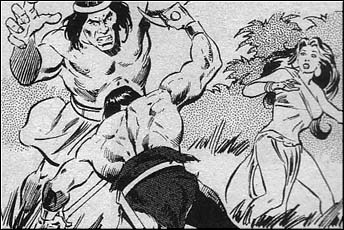
Yezdigerd sent Jehungir Agha to entrap the barbarian on the island of Xapur. Coming early to the ambush, Conan found the island's ancient fortress-palace of Dagon restored by magic, and in it the city's malevolent god, in the form of a giant of living iron ("The Devil in Iron").
After escaping from Xapur, Conan built his Kozaki and pirate raiders into such a formidable threat that King Yezdigerd devoted all his forces to their destruction. After a devastating defeat, the kozaki scattered, and Conan retreated southward to take service in the light cavalry of Kobad Shah, King of Iranistan. Conan got himself into Kobad Shah's bad graces and had to ride for the hills. He found a conspiracy brewing in Yanaidar, the fortress-city of the Hidden Ones. The Sons of Yezm were trying to revive an ancient cult and unite the surviving devotees of the old gods in order to rule the world. The adventure ended with the rout of the contending forces by the gray ghouls of Yanaidar, and Conan rode eastward ("The Flame Knife").
Conan reappeared in the Himelian Mountains on the northwest frontier of Vendhya, as a war chief of the savage Afghuli tribesmen. Now in his early thirties, the warlike barbarian was known and feared throughout the world of the Hyborian Age.

Not a man to be bothered with niceties, Yezdigerd employed the magic of the wizard Khemsa, an adept of the dreaded Black Circle, to remove the Vendhyan king from his path. The dead king's sister, the Devi Yasmina, set out to avenge him but was captured by Conan. Conan and his captive pursued the sorcerous Khemsa, only to see him slain by the magic of the Seers of Yimsha who also abducted Yasmina ("The People of the Black Circle").
When Conan's plans for welding the hill tribes into a single power failed, Conan, hearing of wars in the West, rode thither. Almuric, a prince of Koth, had rebelled against the hated Strabonus. While Conan joined Almuric's bristling host, Strabonus's fellow kings came to that monarch's aid. Almuric's motley horde was driven south, to be annihilated at last by combined Stygian and Kushite forces.
Escaping into the desert, Conan and the camp follower Natala came to age-old Xuthal, a phantom city of living dead men and their creeping shadow-god, Thog. The Stygian woman Thalis, the effective ruler of Xuthal, double-crossed Conan once too often ("The Slithering Shadow").
Conan beat his way back to the Hyborian lands. Seeking further employment, he joined the mercenary army that a Zingaran, Prince Zapayo da Kova, was raising for Argos. It was planned that Koth should invade Stygia from the north, while the Argosseans approached the realm from the south by sea. Koth, however, made a separate peace with Stygia, leaving Conan's army of mercenaries trapped in the Stygian deserts.
Conan fled with Amalric, a young Aquilonian soldier. Soon Conan was captured by nomads, while Amalric escaped. When Amalric caught up again with Conan, Amalric had with him the girl Lissa, whom he had saved from the cannibal god of her native city. Conan had meanwhile become commander of the cavalry of the city of Tombalku. Two kings ruled Tombalku: the Negro Sakumbe and the mixed-blood Zehbeh. When Zehbeh and his faction were driven out, Sakumbe made Conan his co-king. But then the wizard Askia slew Sakumbe by magic. Conan, having avenged his black friend, escaped with Amalric and Lissa ("Drums of Tombalku").
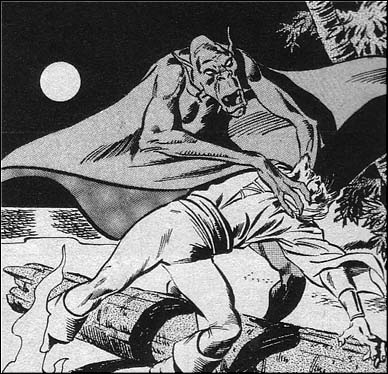
Conan beat his way to the coast, where he joined the Barachan pirates. He was now about thirty-five. As second mate of the Hawk, he landed on the island of the Stygian sorcerer Siptah, said to have a magical jewel of fabulous properties. Siptah dwelt in a cylindrical tower without doors or windows, attended by a winged demon. Conan smoked the unearthly being out but was carried off in its talons to the top of the tower. Inside the tower Conan found the wizard long dead; but the magical gem proved of unexpected help in coping with the demon ("The Gem in the Tower").
Conan remained about two years with the Barachans, according to a set of clay tablets in pre-Sumerian cuneiform. Used to the tightly organized armies of the Hyborian kingdoms, Conan found the organization of the Barachan bands too loose and anarchic to afford an opportunity to rise to leadership. Slipping out of a tight spot at the pirate rendezvous at Tortage, he found that the only alternative to a cut throat was braving the Western Ocean in a leaky skiff. When the Wastrel, the ship of the buccaneer Zaporavo, came in sight, Conan climbed aboard.
The Cimmerian soon won the respect of the crew and the enmity of its captain, whose Kordavan mistress, the sleek Sancha, cast too friendly an eye on the black-maned giant. Zaporavo drove his ship westward to an uncharted island, where Conan forced a duel on the captain and killed him, while Sancha was carried off by strange black beings to a living pool worshiped by these entities ("The Pool of the Black Ones").
Conan persuaded the officials at Kordava to transfer Zaporavo's privateering license to him, whereupon he spent about two years in this authorized piracy. As usual, plots were brewing against the Zingaran monarchy. King Ferdrugo was old and apparently failing, with no successor but his nubile daughter Chabela. Duke Villagro enlisted the Stygian super-sorcerer Thoth-Amon, the High Priest of Set, in a plot to obtain Chabela as his bride. Suspicious, the princess took the royal yacht down the coast to consult her uncle. A privateer in league with Villagro captured the yacht and abducted the girl. Chabela escaped and met Conan, who obtained the magical Cobra Crown, also sought by Thoth-Amon.
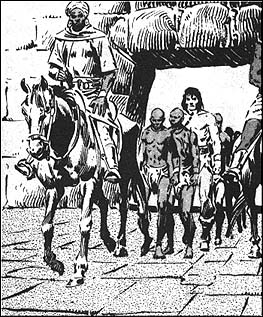
A storm drove Conan's ship to the coast of Kush, where Conan was confronted by black warriors headed by his old comrade-in-arms, Juma. While the chief welcomed the privateers, a tribesman stole the Cobra Crown. Conan set off in pursuit, with Princess Chabela following him. Both were captured by slavers and sold to the black Queen of the Amazons. The Queen made Chabela her slave and Conan her fancy man. Then, jealous of Chabela, she flogged the girl, imprisoned Conan, and condemned both to be devoured by a man-eating tree ("Conan the Buccaneer").
Having rescued the Zingaran princess, Conan shrugged off hints of marriage and returned to privateering. But other Zingarans, jealous, brought him down off the coast of Shem. Escaping inland, Conan joined the Free Companions, a mercenary company. Instead of rich plunder, however, he found himself in dull guard duty on the black frontier of Stygia, where the wine was sour and the pickings poor.
Conan's boredom ended with the appearance of the pirette, Valeria of the Red Brotherhood. When she left the camp, he followed her south. The pair took refuge in a city occupied by the feuding clans of Xotalanc and Tecuhltli. Siding with the latter, the two northerners soon found themselves in trouble with that clan's leader, the ageless witch Tascela ("Red Nails").
Conan's amour with Valeria, however hot at the start, did not last long. Valeria returned to the sea; Conan tried his luck once more in the black kingdoms. Hearing of the "Teeth of Gwahlur", a cache of priceless jewels hidden in Keshan, he sold his services to its irascible king to train the Keshani army.

Thutmekri, the Stygian emissary of the twin kings of Zembabwei, also had designs on the jewels. The Cimmerian, outmatched in intrigue, made tracks for the valley where the ruins of Alkmeenon and its treasure lay hidden. In a wild adventure with the undead goddess Yelaya, the Corinthian girl Muriela, the black priests headed by Gorulga, and the grim gray servants of the long-dead Bit-Yakin, Conan kept his head but lost his loot ("Jewels of Gwahlur").
Heading for Punt with Muriela, Conan embarked on a scheme to relieve the worshipers of an ivory goddess of their abundant gold. Learning that Thutmekri had preceded him and had already poisoned King Lalibeha's mind against him, Conan and his companion took refuge in the temple of the goddess Nebethet.
When the King, Thutmekri, and High Priest Zaramba arrived at the temple, Conan staged a charade wherein Muriela spoke with the voice of the goddess. The results surprised all, including Conan ("The Ivory Goddess").
In Zembabwei, the city of the twin kings, Conan joined a trading caravan that he squired northward along the desert borders, bringing it safely to Shem. Now in his late thirties, the restless adventurer heard that the Aquilonians were spreading westward into the Pictish wilderness. So thither, seeking work for his sword, went Conan. He enrolled as a scout at Fort Tuscelan, where a fierce war raged with the Picts.
In the forests across the river, the wizard Zogar Sag was gathering his swamp demons to aid the Picts. While Conan failed to prevent the destruction of Fort Tuscelan, he managed to warn settlers around Velitrium and to cause the death of Zogar Sag ("Beyond the Black River").
Conan rose rapidly in the Aquilonlan service. As captain, his company was once defeated by the machinations of a traitorous superior. Learning that this officer, Viscount Lucian, was about to betray the province to the Picts, Conan exposed the traitor and routed the Picts ("Moon of Blood").
Promoted to general, Conan defeated the Picts in a great battle at Velitrium and was called back to the capital, Tarantia, to receive the nation's accolades. Then, having roused the suspicions of the depraved and foolish King Numedides, he was drugged and chained in the Ivory Tower under sentence of death.
The barbarian, however, had friends as well as foes. Soon he was spirited out of prison and turned loose with horse and sword. He struck out across the dank forests of Pictland toward the distant sea. In the forest, the Cimmerian came upon a cavern in which lay the corpse and the demon-guarded treasure of the pirate Tranicos. From the west, others -- a Zingaran count and two bands of pirates -- were hunting the same fortune, while the Stygian sorcerer Thoth-Amon took a hand in the game ("The Treasure of Tranicos").
Rescued by an Aquilonian galley, Conan was chosen to lead a revolt against Numedides. While the revolution stormed along, civil war raged on the Pictish frontier. Lord Valerian, a partisan of Numedides, schemed to bring the Picts down on the town of Schohira. A scout, Gault Hagar's son, undertook to upset this scheme by killing the Pictish wizard ("Wolves Beyond the Border").
Storming the capital city and slaying Numedides on the steps of his throne -- which he promptly took for his own -- Conan, now in his early forties, found himself ruler of the greatest Hyborian nation ("Conan the Liberator").
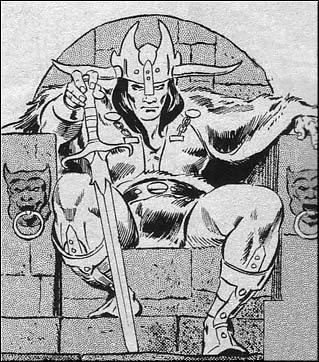
A king's life, however, proved no bed of houris. Within a year, an exiled count had gathered a group of plotters to oust the barbarian from the throne. Conan might have lost crown and head but for the timely intervention of the long-dead sage Epimitreus ("The Phoenix of the Sword").
No sooner had the mutterings of revolt died down than Conan was treacherously captured by the kings of Ophir and Koth. He was imprisoned in the tower of the wizard Tsotha-lanti in the Kothian capital. Conan escaped with the help of a fellow prisoner, who was Tsotha-lanti's wizardly rival Pelias. By Pelias's magic, Conan was whisked to Tarantia in time to slay a pretender and to lead an army against his treacherous fellow kings ("The Scarlet Citadel").
For nearly two years, Aquilonia thrived under Conan's firm but tolerant rule. The lawless, hard-bitten adventurer of former years had, through force of circumstance, matured into an able and responsible statesman. But a plot was brewing in neighboring Nemedia to destroy the King of Aquilonia by sorcery from an elder day.
Conan, about forty-five, showed few signs of age save a network of scars on his mighty frame and a more cautious approach to wine, women and bloodshed. Although he kept a harem of luscious concubines, he had never taken an official queen; hence he had no legitimate son to inherit the throne, a fact whereof his ememies sought to take advantage.
The plotters resurrected Xaltotun, the greatest sorcerer of the ancient empire of Acheron, which fell before the Hyborian savages 3,000 years earlier. By Xaltotun's magic, the King of Nemedia was slain and replaced by his brother Tarascus. Black sorcery defeated Conan's army; Conan was imprisoned, and the exile Valerius took his throne.
Escaping from a dungeon with the aid of the harem girl Zenobia, Conan returned to Aquilonia to rally his loyal forces against Valerius. From the priests of Asura, he learned that Xaltotun's power could be broken only by means of a strange jewel, the "Heart of Ahriman." The trail of the jewel led to a pyramid in the Stygian desert outside black-walled Khemi. Winning the Heart of Ahriman, Conan returned to face his foes ("Conan the Conqueror", originally published as "The Hour of the Dragon").
After regaining his kingdom, Conan made Zenobia his queen. But, at the ball celebrating her elevation, the Queen was borne off by a demon sent by the Khitan sorcerer Yah Chieng. Conan's quest for his bride carried him across the known world, meeting old friends and foes. In purple- towered Paikang, with the help of a magical ring, he freed Zenobia and slew the wizard ("Conan the Avenger", originally published as "The Return of Conan").
Home again, the way grew smoother. Zenobia gave him heirs: a son named Conan, but commonly called Conn, another son called Taurus and a daughter. When Conn was twelve, his father took him on a hunting trip to Gunderland. Conan was now in his late fifties. His sword arm was a little slower than in his youth, and his black mane and the fierce mustache of his later years were traced with gray; but his strength still surpassed that of two ordinary men.
When Conn was lured away by the Witchmen of Hyperborea, who demanded that Conan come to their stronghold alone, Conan went. He found Louhi, the High Priestess of the Witchmen, in conference with three others of the world's leading sorcerers: Thoth-Amon of Stygia; the god-king of Kambuja; and the black lord of Zembabwei. In the ensuing holocaust, Louhi and the Kambujan perished, while Thoth-Amon and the other sorcerer vanished by magic ("The Witch of the Mists").
Old King Ferdrugo of Zingara had died, and his throne remained vacant as the nobles intrigued over the succession. Duke Pantho of Guarralid invaded Poitain, in southern Aquilonia. Conan, suspecting sorcery, crushed the invaders. Learning that Thoth-Amon was behind Pantho's madness, Conan set out with his army to settle matters with the Stygian. He pursued his foe to Thoth-Amon's stronghold in Stygia ("Black Sphinx of Nebthu"), to Zembabwei ("Red Moon of Zembabwei"), and to the last realm of the serpent folk in the far south ("Shadows in the Skull").
For several years, Conan's rule was peaceful. But time did that which no combination of foes had been able to do. The Cimmerian's skin became wrinkled and his hair gray; old wounds ached in damp weather. Conan's beloved consort Zenobia died giving birth to their second daughter.
Then catastrophe shattered King Conan's mood of half-resigned discontent. Supernatural entities, the Red Shadows, began seizing and carrying off his subjects. Conan was baffled, until in a dream he again visited the sage Epimitreus. He was told to abdicate in favor of Prince Conn and set out across the Western Ocean.
Conan discovered that the Red Shadows had been sent by the priest-wizards of Antillia, a chain of islands in the western part of the ocean, whither the survivors of Atlantis had fled 8,000 years before. These priests offered human sacrifices to their devil-god Xotli on such a scale that their own population faced extermination.
In Antillia, Conan's ship was taken, but he escaped into the city of Ptahuacan. After conflicts with giant rats and dragons, he emerged atop the sacrificial pyramid just as his crewmen were about to be sacrificed. Supernatural conflict, revolution and seismic catastrophe ensued. In the end, Conan sailed off to explore the continents to the west ("Conan of the Isles").
Whether he died there, or whether there is truth in the tale that he strode out of the West to stand at his son's side in a final battle against Aquilonia's foes, will be revealed only to him who looks, as Kull of Valusia once did, into the mystic mirrors of Tuzun Thune.
